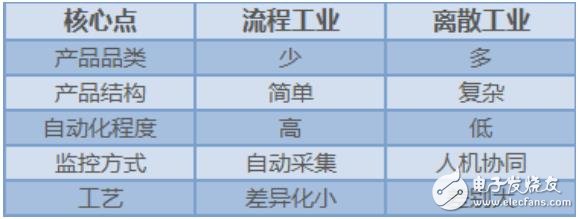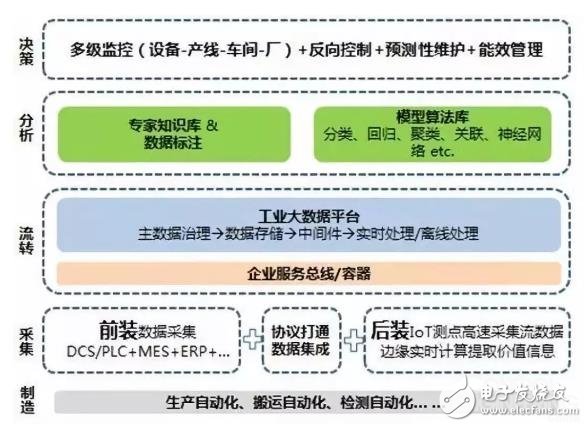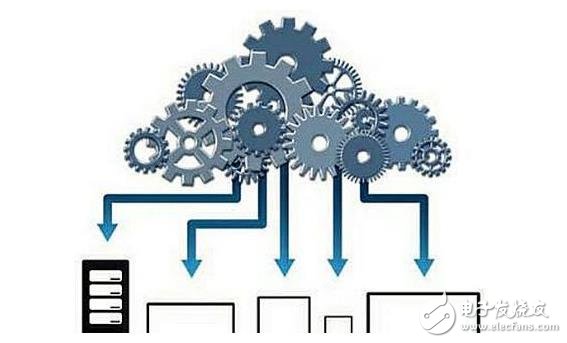Industry is generally divided into process industries and discrete industries. The biggest difference between the two is the degree of automation in production, the availability of data, and the complexity of the industry. The biggest commonality is that each scenario has different needs. To enter any segment, you need to have a deep enough industry knowhow. And the ability to integrate upstream and downstream resources.

Intelligence can be understood as data and the AI ​​built on it. Starting with production line automation, multi-source heterogeneous industrial data is collected, streamed, analyzed and helped to form decision-making and control. The end-to-end solution forms a typical portrait of the current industry player.

The total GDP of industry, especially manufacturing, is much higher than that of retail, finance, construction and other industries. The amount of effective data generated every day in the industrial sector is no less than that of Internet companies such as BAT. A large-scale factory can generate billions to hundreds of billions of data per day.
barrierAlthough industrial scenes produce high-frequency, massive data every day, a large amount of raw data itself is not directly meaningful, and it is possible to generate large-scale delays and occupy a large amount of bandwidth. We not only need real-time monitoring and analysis in some scenarios, but also need to collect more data into the cloud to do more peacekeeping and longer-term economic benefits and value analysis, which is the value of cloud computing. Cloud computing + edge computing, which is a finer granularity and more complex architecture than the traditional consumer Internet, also means higher barriers.
Inflection pointThe logic of the Internet is called "Copy to China", and "Copy to Industry" is the same. Large-scale data applications and platform architectures have undergone sufficient verification and evolution in industries such as finance and telecommunications, and the catalytic role of China Manufacturing 2025 on the policy side constitutes a prerequisite for the establishment of the turning point.
Industrial intelligence player portrait At this stage, users need not a single product, but an end-to-end overall solution. A qualified industrial intelligence company should have the construction capabilities of a total solution.
First of all, user demand is always the first, and the technology that does not meet the demand is a pseudo-proposition. In addition, a good solution starts with a perfect architecture. For the industrial scene, from the integration of internal and external multi-source data, to the cloud + end platform architecture, the establishment of the knowledge base, the selection of the appropriate model, and then the reverse decision-making and control, only a complete open can form a closed loop.
Overall, industrial intelligence presents a landscape (overall architecture) + N vertical (multiple sub-sectors).
For the big B customers in the industrial field, what is needed at this stage is not a single product, but an end-to-end overall solution. Although this is the status quo, it is actually the ultimate goal of industrial entrepreneurs. However, path selection is important.
Regarding the development path, the mainstream in the industry believes that automation-(data)-informatization-intelligence is a reasonable order for industrial users to advance, and the previous stage is a necessary condition for the start of the latter stage. Therefore, enterprises in the field of industrial intelligence in China have only paid attention to opportunities in the field of automation for a long time, and even equated industrial intelligence with “robot†or “industrial automationâ€. Judging from the extensive practice of the user site, there are significant sequences in these stages, but at the same time cross-infiltration and iterative.
In concrete terms, most of the customers in the discrete manufacturing industry are not fully automated, so the production line automation is prioritized. Some manufacturers use industrial Ethernet and board to realize device interconnection, open device-level data, and feed back to the platform layer through MES, realize preliminary material association on the basis of not replacing the original industrial control equipment, and the user acceptance is very high. The growth is very obvious. This type of model, we can call it "system integration with M2M device IoT as the core".
Further demand, from the large head customers in the discrete manufacturing industry and the vast majority of customers in the process manufacturing industry, due to the high degree of automation of the production line, we have observed that such customers are more accepting of information technology. high.
In addition, there is a class of vendors that can directly cut in from the top-level design, and serve users at the platform level with industrial big data platforms or scenario AI models to solve business problems in real time. Conversely, at the data acquisition layer, sensors are installed in some areas where data is imperfect, intelligent detection equipment is installed, and even a small line of production line integration is performed. This type of model, user acceptance is often higher, which means that the project's premium is often higher, we can call it "system integration with data application as the core."
Therefore, we can see three development paths, different routes, different scenarios, different development stages, and different paths:
1. System integration with production line automation as the core;
Second, system integration with M2M equipment IoT as the core;
Third, the system integration with data application as the core.
Of course, the same goal, the ultimate goal is to provide users with a total solution to meet user needs as the core.
First of all, where is the data?
â–² One type of management data: structured SQL data, such as product attributes, processes, production, procurement, orders, services, etc., such data generally come from the enterprise's ERP, SCM, PLM and even MES systems, data volume It is not big, but it has great mining value;
â–² The other type is machine operation and IoT data: mostly unstructured, streaming data, such as equipment operating conditions (pressure, temperature, vibration, stress, etc.), audio and video, log text and other data, such data is generally Collected from the equipment PLC, SCADA and some external sensors, the data volume is large, the acquisition frequency is high, and some pre-processing needs to be done locally with the edge calculation.

In general, due to the fragmentation and dispersion of scenes, industrial data itself has the characteristics of large quantity, multi-source, heterogeneous, and high-time requirements, and these features will be further strengthened with the gradual access of 28 billion devices in the future. It is one of the core difficulties in industrial big data services, and the Internet big data is not only of different magnitude, structure is different, and applications are completely different.
Second, based on these industrial data, what services should the platform layer provide?
â–² Complete protocol analysis: Data collection must first complete the opening of the industrial agreement. Taking the application layer protocol as an example, EtherNet/IP and PROFINET have the largest market share, followed by EtherCAT, Modbus-TCP and EtherNetPOWERLINK;
â–²Standardized data integration: Collecting the data to be unified master data management, the first step is to establish standards. In general, it is important that we first use ISO or other industry standards to develop uniform coding, structure, routing, and attributes to ensure data consistency.
In the course of project implementation, it is also important to gradually accumulate industry knowledge bases, appropriate algorithm components and related mechanism models. This is a key step in the evolution from data standards to business standardization, and to achieve real product level micro Service has laid the foundation.
Powerful PaaS support: The particularity of industrial data itself leads to a platform with strong mid-level support. Let's take a time series database as an example. It is a typical type of equipment condition and sensor data. This kind of data is high in frequency and large in quantity. It is processed by the traditional relational database. It is necessary to pull out all the values ​​every time, and the throughput is extremely high and the performance is very poor. Therefore, a highly compressed, high-performance time series database is one of the necessary capabilities of the platform layer.
Finally, what applications should we do?
â–² Equipment level: quality control. In the era of industrial intelligence, if we can collect appropriate real-time data, combined with the mechanism model applied to the device, it is possible to use machine learning to dig out the correlation or causal relationship between product quality and key data. It is possible to achieve real-time online quality control and fault warning. If the data frequency can form a perfect envelope for the process, we are also likely to achieve maximum efficiency.
â–²Factory level: planned to arrange production. The ultimate goal of industrial intelligence is to achieve large-scale personalization, namely C2M. The goal of this problem is to achieve the optimal local production capacity at that time. The constraints are from the production line equipment, personnel, product attributes, supply chain data, etc. Through the study and training of historical data, it is not difficult to form a better prediction. model.
This model can be dynamically adjusted according to the dynamic analysis of real-time data of production lines and factories to help enterprises achieve accurate control and maximize economic benefits.
In the foreseeable future, as the integrity and reliability of data become higher and higher, the scenes become more and more abundant, and the data application level will give birth to a number of priority enterprises. They help industrial users reduce costs, improve efficiency, and solve real problems. Real business problems.
Box Gun Bar(196)
Box Gun Bar(196),Air Bar Max Puffs,Air Bar Max Puffs Vape,High Pro Max Puffs Bar
KENNEDE ELECTRONICS MFG CO.,LTD. , https://www.axavape.com